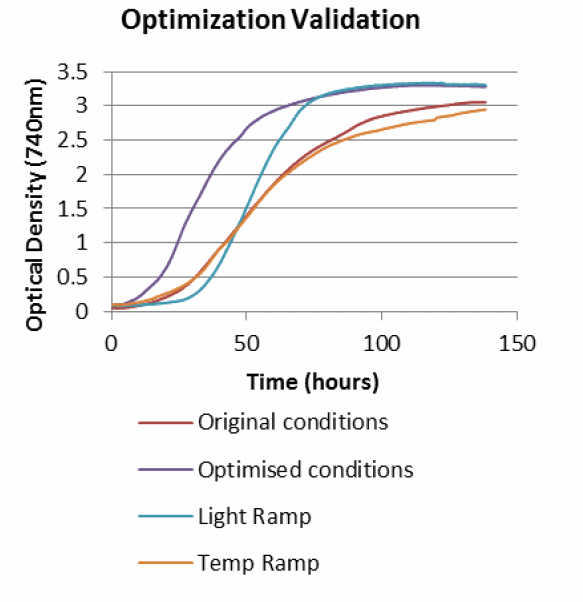Algem® Culture Optimization - ALG App001
algenuity • June 12, 2016
The Problem
Optimizing lighting and temperature conditions for an algal strain has always presented a challenge for researchers, often taking dozens of experiments over the course of months. With the Algem® Photobioreactor System, Algenuity has developed a strategy for optimizing culture conditions using a single Algem in just six experiments over the course of three experimental runs. For many strains this can be done in as little as three weeks.
Experimental Design
Preliminary run:
Flask 1/2 – Pre-optimized
conditions run in duplicate. These can be previously used values, or ones taken from the literature or other groups. This experiment acts as a baseline, and gives an idea of experimental timescale related to average cell doubling time.
Optimization runs
: Flask 1 – Temperature ramp
. Lighting is kept constant at the pre-optimized value, temperature is initially maintained at the same as the control culture then ramped from this value to a value that is 50% higher than the pre-optimized value. The timing of the ramp is calibrated to correspond with the logarithmic phase of the growth curve obtained in the preliminary run.
Flask 2 – Lighting ramp
. Temperature is kept constant at the pre-optimized value, Lighting is initially kept the same as the control through a pre-determined lag period then ramped from 100mE to 2000mE using the preset ‘sunlight’ option or 100% white LED lighting only. The timing of the ramp is again calibrated to correspond with the logarithmic phase of the growth curve obtained in the preliminary run.
These data are analyzed using primary derivative extrapolations to determine optimal values for lighting and temperature.
Validation runs: Flask 1/2 – Optimized conditions (minus 10%) in duplicate
. The data from the light and temperature ramps are processed and optimal values derived corresponding to the maximal value for light or temperature before an increase becomes detrimental. This value is necessarily an over-estimate as the ramp causes acclimatization; the calculated value is, therefore, decreased by 10% of the ramp range.





